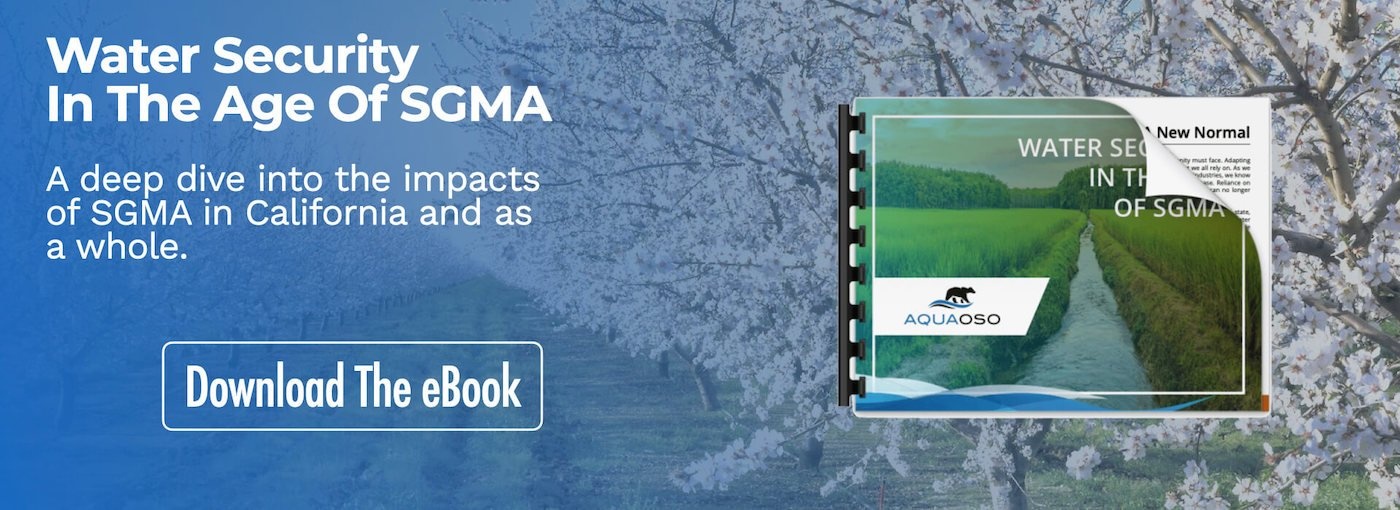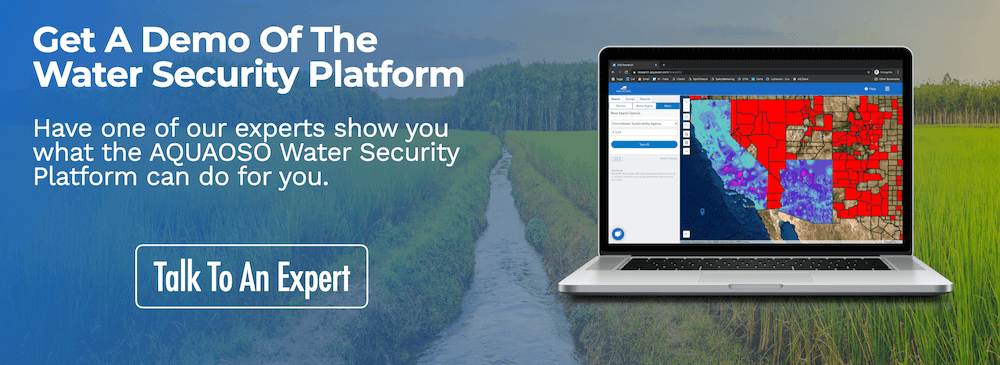Sustainable Water Use in 2020 – Celebrating the Water Wins
2020 was a challenging year. The issue of water scarcity, stress, and quality was no exception. But it wasn’t all bad news, it is important to celebrate the wins and use them to both find and spread some inspiration going into 2021; use the good news as a spur toward a water-resilient future.
AQUAOSO put together this list of positive news relating to sustainable water use in 2020 – from technology to policy – to do just that. The goal is to shine a light on the positives and motivate readers to learn more about water issues and encourage more progress in the years to come.
“Water risk mitigation and water resilience are possible AND they can be financially beneficial to the stakeholders involved. As these mutually beneficial scenarios are uncovered, the ceiling of potential business, social, and environmental benefits rises. If these scenarios are incentivized and acted upon, the ceiling breaks – and then there is nothing but blue skies.”
-Mark Jackson, AQUAOSO
The AQUAOSO team is optimistic that with more accessible information and better tools, businesses can lessen their individual water risk while decreasing the water risk of the planet as a whole.
Water Wins of 2020
1. Sustainable Water Use Technology
AQUAOSO has already written about future methods of conserving water in agriculture, such as indoor farming, smart tractors, and drones, but water innovations don’t stop there. The World Bank writes about several recent technologies being rolled out around the world as part of the Imagine H2O water innovation accelerator.
These include Ignitia, which “uses machine learning and remote sensing to send text messages to small-scale farmers with hyper-local information on climates and weather forecasts”. Another company, Oneka, produces “wave-powered desalination buoys [that] convert ocean water to drinking water” in Small Island Developing States.
2. Irrigation Improvements
Irrigation improvements range from straightforward to complex. In Egypt, the World Bank reports on how “modernizing irrigation systems improved water security” for local farmers. Nearly 20,000 water users benefit from reduced reliance on diesel pumps and the introduction of a modern electricity grid to power electric pumps.
In Colorado, farmers are switching from flood irrigation methods to micro-sprinklers in order to minimize runoff and reduce the amount of salt and selenium ending up in the Colorado River. Water quality has improved dramatically since the 1960s when it was too salty for downstream farmers in Mexico to irrigate their crops. The Colorado River Basin Salinity Control Program and related incentives have had a major impact.
3. Water Recharge Operations
Water recharge initiatives are key to replenishing overdrawn aquifers, especially in California, where over 20 basins are considered to be critically overdrawn. A recent announcement that $60 million in state surplus funds will be directed toward aquifer recharge projects was welcomed by Groundwater Sustainability Agencies.
In Utah, the state legislature took steps to introduce water banking to the state, with a pilot program that will run for the next three years. Its goals include “adding flexibility to rigid water rights” and “facilitating and supporting water markets.”
It can be expected to see more programs like this in the years ahead as states look for market-driven strategies to maximize the utility of available water.
4. Corporate Initiatives
Agriculture accounts for the vast majority of water use in the U.S., but decisions up and down the supply chain can also have an effect on water sustainability practices. A report by Ceres called Feeding Ourselves Thirsty found that “corporate boards are becoming more water-aware” and that “water-efficiency goals are standard practice.”
While not in 2020, a still-notable example is PepsiCo, which launched a Positive Water Impact initiative with the help of the Nature Conservancy. In addition to improving water use efficiency overall, they’ve “set a goal to replenish 100 percent of the water we consume in manufacturing operations located in high-water-risk areas, ensuring that such replenishment takes place in the same watershed where the extraction has occurred.”
In a similar initiative, Microsoft has pledged to become “water positive” by 2030, which means it will “replenish more water than it consumes on a global basis.” This includes reducing the amount of water it will use to cool new data centers in Arizona.
5. Legislation
AQUAOSO talks a lot about SGMA because its incremental rollout means that there’s always something new to report. In fact, 2020 is the year when the first set of Groundwater Sustainability Plans were due in certain overdrafted basins.
But there were plenty of other legislative developments in the water sector, including the Water Resources Development Act, which will provide $10 billion in federal funding for water infrastructure projects, including conservation and ecosystem restoration projects. The Audubon Society praised the bill for addressing “dwindling water supplies while protecting our economy and birds such as the Southwestern Willow Flycatcher.”
6. Private Sector Cooperation
Legislation won’t be enough to address water scarcity issues on its own. Fortunately, the private sector is stepping up to the challenge like never before. The CEO Water Mandate, a U.N. initiative, launched the Water Resilience Coalition in March 2020, which is a “CEO-led initiative committed to reducing water stress by 2050.” Their guiding principles emphasize collaboration and public-private partnerships:
“Through collaboration, investment in infrastructure, innovation and policy advocacy, and by engaging supply chain partners and non-governmental organizations (NGOs) in the effort, businesses can help lead the way on water basin resilience.”
Additionally, investors have been increasingly shifting their attention to impact investing, which includes funds focused on climate change and sustainable water use.
7. AQUAOSO’s Water Security Platform
AQUAOSO is contributing to these efforts by expanding the reach of the Water Security Platform, which aggregates data from multiple resources to provide actionable insights to be the right hand of businesses in their identification, understanding, monitoring, and mitigation of water risk. In 2020, we’ve rolled out our platform to more regions, furthered the education of water risk mitigation, and significantly added to our library of water risk resources.
Lenders, investors, and other professionals can turn to AQUAOSO to look up the water risk associated with loans, land deals, and other agricultural investments on a parcel-by-parcel basis. AQUAOSO believes that access to better data is one of the key drivers of smart water management.
8. Growing Calls for Positive Action
Finally, one of the most notable trends in sustainable water use in 2020 is the growing awareness that water stress is a problem that needs to be addressed. This includes the recognition that climate change and water scarcity are inextricably linked.
The Secretary-General of the U.N. points out that “water is the primary medium through which we perceive the effects of climate disruption, from extreme weather events, such as droughts and floods, to glacial melting, saltwater intrusion and sea-level rise.” He argues that “everyone has a role to play” in responding to these issues.
The easiest and most-actionable way to understand water issues is in terms of risk. If there is an understanding of risk, accompanied by the right data and information, that risk can be mitigated, and steps to reduce and eliminate water issues can be taken.
According to an article in LegalPlanet on water data in California, “Civic engagement in water data matters – but there are different understandings of what it means.”
AQUAOSO is here to respond to these calls to action with tools that are accurate, up-to-date, and user-friendly, making it easy for stakeholders to mitigate their water risk.
Why These Trends Matter
Sometimes, positive water news can seem like a drop in the bucket against the fires, floods, and other natural disasters that were seen in 2020. But that’s all the more reason for us to take stock of the good news. These trends are real and should give optimism for the years to come.
The Nature Conservancy asks the question, “Could the Legacy of 2020 be Nature Positive?” While it’s too early to say, AQUAOSO is hopeful that the answer will be “yes,” and that 2021 will see even more water risk mitigation and sustainable water use in agriculture and other industries.
As the Conservancy puts it, “the financial pathways leading to a nature-positive future are straightforward.” Businesses – people – just need to take the steps to get there.
Read more about water trends in this explorable guide.
The Bottom Line
These positive trends in sustainable water use have been one of the bright spots of 2020. From innovative technologies like Oneka’s desalination buoys to Utah’s water banking pilot program, there are plenty of projects to look out for on the horizon.
But many of these projects will need additional investments, collaboration, and above all, access to better water data to stay afloat. At AQUAOSO, we hope to fill this gap with the Water Security Platform and other resources.
Contact us today to find out how we can help with your water conservation initiative, or request a free demo of our Water Security Platform.
Recent Posts
Agcor and AgWare Celebrate 2 Years of Groundbreaking Integration, Setting the Standard in Agricultural Appraisal Efficiency
PRESS RELEASE For Immediate Release DENVER, March 21, 2024 -- Agcor, an AQUAOSO Technologies, PBC brand, a leading provider of agricultural lending software solutions, announces a significant milestone in its partnership with AgWare, a premier developer of innovative...
AQUAOSO launches Agcor – a full suite of digital tools for the modern ag lender.
PRESS RELEASE For Immediate Release Denver, CO - Today, AQUAOSO Technologies, PBC officially unveiled Agcor™ - a suite of software tools for the modern ag lender. The software is purpose-built by and for agricultural lenders to unlock the power of...
AQUAOSO’s Climate Intelligence Platform Showcased At OnRamp Conference
PRESS RELEASE For Immediate Release AQUAOSO showcases GIS Connect, a climate intelligence platform that helps US financial institutions mitigate climate risk during the recent OnRamp Agriculture conference. AQUAOSO shares their story of substantial growth as...



